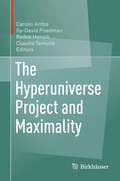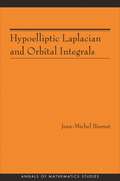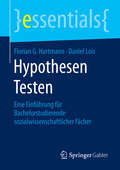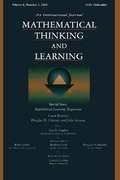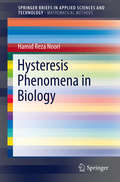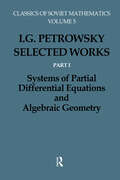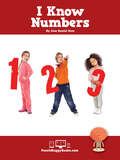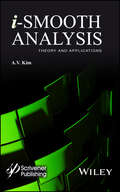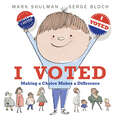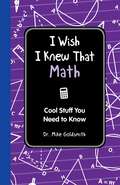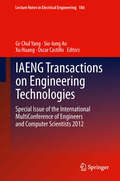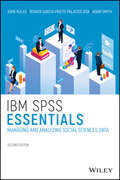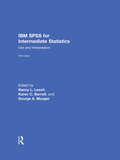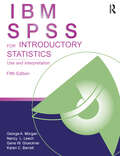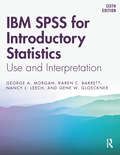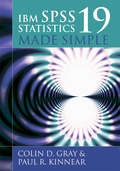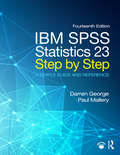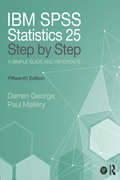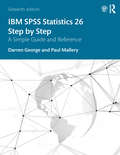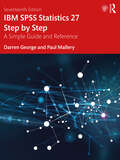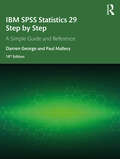- Table View
- List View
The Hyperuniverse Project and Maximality
by Carolin Antos Sy-David Friedman Radek Honzik Claudio TernulloThis collection documents the work of the Hyperuniverse Project which is a new approach to set-theoretic truth based on justifiable principles and which leads to the resolution of many questions independent from ZFC. The contributions give an overview of the program, illustrate its mathematical content and implications, and also discuss its philosophical assumptions. It will thus be of wide appeal among mathematicians and philosophers with an interest in the foundations of set theory. The Hyperuniverse Project was supported by the John Templeton Foundation from January 2013 until September 2015
Hypoelliptic Laplacian and Orbital Integrals (Annals of Mathematics Studies #177)
by Jean-Michel BismutThis book uses the hypoelliptic Laplacian to evaluate semisimple orbital integrals in a formalism that unifies index theory and the trace formula. The hypoelliptic Laplacian is a family of operators that is supposed to interpolate between the ordinary Laplacian and the geodesic flow. It is essentially the weighted sum of a harmonic oscillator along the fiber of the tangent bundle, and of the generator of the geodesic flow. In this book, semisimple orbital integrals associated with the heat kernel of the Casimir operator are shown to be invariant under a suitable hypoelliptic deformation, which is constructed using the Dirac operator of Kostant. Their explicit evaluation is obtained by localization on geodesics in the symmetric space, in a formula closely related to the Atiyah-Bott fixed point formulas. Orbital integrals associated with the wave kernel are also computed. Estimates on the hypoelliptic heat kernel play a key role in the proofs, and are obtained by combining analytic, geometric, and probabilistic techniques. Analytic techniques emphasize the wavelike aspects of the hypoelliptic heat kernel, while geometrical considerations are needed to obtain proper control of the hypoelliptic heat kernel, especially in the localization process near the geodesics. Probabilistic techniques are especially relevant, because underlying the hypoelliptic deformation is a deformation of dynamical systems on the symmetric space, which interpolates between Brownian motion and the geodesic flow. The Malliavin calculus is used at critical stages of the proof.
Hypothesen Testen: Eine Einführung für Bachelorstudierende sozialwissenschaftlicher Fächer (essentials)
by Florian G. Hartmann Daniel LoisDie Sozialwissenschaftler Florian G. Hartmann und Daniel Lois erklären in diesem Essential Schritt für Schritt und auf Nachvollziehbarkeit bedacht, wie im Rahmen einer quantitativen Untersuchung Hypothesen überprüft werden. Dabei werden methodische und statistische Grundbegriffe besprochen und komplexere Sachverhalte anhand von alltagsnahen Beispielen erläutert. Die Autoren schöpfen bei den Erklärungen aus ihrer Lehr- und Forschungstätigkeit und berücksichtigen die Erfahrungen ihres eigenen Studiums.
Hypothetical Learning Trajectories: A Special Issue of Mathematical Thinking and Learning
by Douglas H. Clements Julie SaramaThe purpose of this special issue is to present several research perspectives on learning trajectories with the intention of encouraging the broader community to reflect on, better define, adopt, adapt, or challenge the concept. The issue begins by briefly introducing learning trajectories. The remaining articles provide elaboration, examples, and discussion of the construct. They purposefully are intended to be illustrative, exploratory, and provocative with regard to learning trajectories construct; they are not a set of verification studies.
Hysteresis Phenomena in Biology
by Hamid Reza NooriThe occurrence of hysteresis phenomena has been traditionally associated with mechanical and magnetic properties of materials. However, recent studies on the dynamics of biological processes suggest switch-like behavior that could be described by mathematical models of hysteresis. This book presents the milestones and perspectives of biological hysteresis and provides a comprehensive and application-oriented introduction to this subject. The target audience primarily comprises researchers but the book may also be beneficial for graduate students.
I Am So 3!: Look at Everything I Can Do!
by Sandrina KurtzShow your three-year-old all the amazing activities he or she can do! In this adorable picture book, help your child learn all the amazing things that they can do now that they&’re three! Encourage your child to not only do playful activities like paint a picture or throw a ball, but also helpful chores like watering the flowers, feeding their pet, and even putting on their own socks. Your child will learn to see normal household tasks as fun accomplishments to add to their list. With bright illustrations and easy-to-understand language, I Am So 3! will have your child excited about all the things they can do now that they&’re three.
I Can Count to Ten and Back Again
by Linda HaywardWhen Big Bird runs a convenience store, he tries to store things that he thinks his friends would like to buy. Will they buy what he thinks they will like or will they surprise him?
“I Don’t See Color”: Personal and Critical Perspectives on White Privilege
by Bettina Bergo Eula Biss Tracey NichollsWho is white, and why should we care? There was a time when the immigrants of New York City’s Lower East Side—the Irish, the Poles, the Italians, the Russian Jews—were not white, but now “they” are. There was a time when the French-speaking working classes of Quebec were told to “speak white,” that is, to speak English. Whiteness is an allegorical category before it is demographic.This volume gathers together some of the most influential scholars of privilege and marginalization in philosophy, sociology, economics, psychology, literature, and history to examine the idea of whiteness. Drawing from their diverse racial backgrounds and national origins, these scholars weave their theoretical insights into essays critically informed by personal narrative. This approach, known as “braided narrative,” animates the work of award-winning author Eula Biss. Moved by Biss’s fresh and incisive analysis, the editors have assembled some of the most creative voices in this dialogue, coming together across the disciplines. Along with the editors, the contributors are Eduardo Bonilla-Silva, Nyla R. Branscombe, Drucilla Cornell, Lewis R. Gordon, Paget Henry, Ernest-Marie Mbonda, Peggy McIntosh, Mark McMorris, Marilyn Nissim-Sabat, Victor Ray, Lilia Moritz Schwarcz, Louise Seamster, Tracie L. Stewart, George Yancy, and Heidi A. Zetzer.
I.G.Petrovskii:Selected Wrks P
by Olga Oleinik I.G. Petrovskii G.A. YosifanThis book contains the major works of Ivan Georgievich Petrowsky on systems of partial differential equations and algebraic geometry. The articles are of crucial importance for the topology of real algebraic manifolds and are the source of intensive development of theory of real algebraic manifolds.
I Know Numbers
by Lisa Daniel ReesI Know Numbers is a fun informational picture eBook and introduction for kids ages three to seven to learn how to count and recognize numbers found in real life settings. This colorful e-book is a must have for kindergarden and primary school students learning to recognize and count numbers.The non-fiction e-book includes beautiful full color photography and cartoon characters to make learning fun and is great for reference and activities.
i-Smooth Analysis: Theory and Applications
by A. V. KimThe edition introduces a new class of invariant derivatives and shows their relationships with other derivatives, such as the Sobolev generalized derivative and the generalized derivative of the distribution theory. This is a new direction in mathematics. i-Smooth analysis is the branch of functional analysis that considers the theory and applications of the invariant derivatives of functions and functionals. The important direction of i-smooth analysis is the investigation of the relation of invariant derivatives with the Sobolev generalized derivative and the generalized derivative of distribution theory. Until now, i-smooth analysis has been developed mainly to apply to the theory of functional differential equations, and the goal of this book is to present i-smooth analysis as a branch of functional analysis. The notion of the invariant derivative (i-derivative) of nonlinear functionals has been introduced in mathematics, and this in turn developed the corresponding i-smooth calculus of functionals and showed that for linear continuous functionals the invariant derivative coincides with the generalized derivative of the distribution theory. This book intends to introduce this theory to the general mathematics, engineering, and physicist communities.
I Voted: Making a Choice Makes a Difference
by Mark ShulmanAs we approach the 2022 midterm elections, this witty, nonpartisan book will help explain the concept of voting to the youngest readers.I Voted explains the concept of choosing, individually, and as a group, from making a simple choice: "Which do you like better, apples or oranges?", to selecting a class pet, to even more complicated decisions, like electing community representatives. You may not always get want you want, but there are strategies to better your odds! Serge Bloch's effortless and charming illustrations paired with Mark Shulman's funny and timely text create a perfect resource for discussing current events with your children.Backmatter includes information about the United States electoral process.Selected for the CBC Champions of Change ShowcaseA Junior Library Guild SelectionA Bank Street Best Children's Book of the Year!
I Wish I Knew That: Math
by Michael GoldsmithMath, so often a mystery to children, is simply explained in I Wish I Knew That Math. With clear, commonsense explanations of mathematical concepts and fun and interesting applications, this book is a great way to increase your understanding of math. The concepts addressed include, but are certainly not limited to: Basic operations - addition, subtraction, multiplication and division The math behind money The connections between math and music Irrational numbers - Why did Pythagoras have one of his followers killed just for talking about the square root of 2? The value of zero Angles - from acute, all the way to reflexive Coordinates and the Cartesian plane Probability - What is the likelihood of being struck by lightning? Logic - induction, deduction and Sherlock Holmes Computers and algorithms Code breaking - from ancient Rome to super computers With its readable style and engaging examples, I Wish I Knew That: Math can give children a head start or a helping hand in their understanding of math. Even grownups could learn a thing or two that they may have forgotten or maybe things they never learned at all!
IAENG Transactions on Engineering Technologies
by Xu Huang Oscar Castillo Gi-Chul Yang Sio-Iong AoThis volume contains revised and extended research articles written by prominent researchers participating in the conference. Topics covered include engineering physics, communications systems, control theory, automation, engineering mathematics, scientific computing, industrial engineering, and industrial applications. IAENG Transactions on Engineering Technologies: Special Issue of the International MultiConference of Engineers and Computer Scientists 2012 offers the state of art of tremendous advances in engineering technologies and physical science and applications, and also serves as an excellent reference work for researchers and graduate students working with/on engineering technologies and physical science and applications.
IAENG Transactions on Engineering Technologies
by Burghard B. Rieger Haeng Kon Kim Sio-Iong AoThis volume contains thirty revised and extended research articles written by prominent researchers participating in an international conference in engineering technologies and physical science and applications. The conference serves as good platforms for the engineering community to meet with each other and to exchange ideas. The conference has also struck a balance between theoretical and application development. The conference is truly international meeting with a high level of participation from many countries. Topics covered include chemical engineering, circuits, communications systems, control theory, engineering mathematics, systems engineering, manufacture engineering, and industrial applications. The book offers the state of art of tremendous advances in engineering technologies and physical science and applications, and also serves as an excellent reference work for researchers and graduate students working with/on engineering technologies and physical science and applications.
IBM SPSS Essentials: Managing and Analyzing Social Sciences Data
by John T. Kulas Renata Garcia Prieto Palacios Roji Adam M. SmithMaster the fundamentals of SPSS with this newly updated and instructive resource The newly and thoroughly revised Second Edition of SPSS Essentials delivers a comprehensive guide for students in the social sciences who wish to learn how to use the Statistical Package for the Social Sciences (SPSS) for the effective collection, management, and analysis of data. The accomplished researchers and authors provide readers with the practical nuts and bolts of SPSS usage and data entry, with a particular emphasis on managing and manipulating data. The book offers an introduction to SPSS, how to navigate it, and a discussion of how to understand the data the reader is working with. It also covers inferential statistics, including topics like hypothesis testing, one-sample Z-testing, T-testing, ANOVAs, correlations, and regression. Five unique appendices round out the text, providing readers with discussions of dealing with real-world data, troubleshooting, advanced data manipulations, and new workbook activities. SPSS Essentials offers a wide variety of features, including: A revised chapter order, designed to match the pacing and content of typical undergraduate statistics classes An explanation of when particular inferential statistics are appropriate for use, given the nature of the data being worked with Additional material on understanding your data sample, including discussions of SPSS output and how to find the most relevant information A companion website offering additional problem sets, complete with answers Perfect for undergraduate students of the social sciences who are just getting started with SPSS, SPSS Essentials also belongs on the bookshelves of advanced placement high school students and practitioners in social science who want to brush up on the fundamentals of this powerful and flexible software package.
IBM SPSS for Intermediate Statistics: Use and Interpretation, Fifth Edition
by George A. Morgan Nancy L. Leech Karen C. BarrettDesigned to help readers analyze and interpret research data using IBM SPSS, this user-friendly book shows readers how to choose the appropriate statistic based on the design; perform intermediate statistics, including multivariate statistics; interpret output; and write about the results. The book reviews research designs and how to assess the accuracy and reliability of data; how to determine whether data meet the assumptions of statistical tests; how to calculate and interpret effect sizes for intermediate statistics, including odds ratios for logistic analysis; how to compute and interpret post-hoc power; and an overview of basic statistics for those who need a review. Unique chapters on multilevel linear modeling; multivariate analysis of variance (MANOVA); assessing reliability of data; multiple imputation; mediation, moderation, and canonical correlation; and factor analysis are provided. SPSS syntax with output is included for those who prefer this format. The new edition features: * IBM SPSS version 22; although the book can be used with most older and newer versions * New discusiion of intraclass correlations (Ch. 3) * Expanded discussion of effect sizes that includes confidence intervals of effect sizes (ch.5) * New information on part and partial correlations and how they are interpreted and a new discussion on backward elimination, another useful multiple regression method (Ch. 6) * New chapter on how to use a variable as a mediator or a moderator (ch. 7) * Revised chapter on multilevel and hierarchical linear modeling (ch. 12) * A new chapter (ch. 13) on multiple imputation that demonstrates how to deal with missing data * Updated web resources for instructors including PowerPoint slides and answers to interpretation questions and extra problems and for students, data sets, chapter outlines, and study guides. IBM SPSS for Intermediate Statistics, Fifth Edition provides helpful teaching tools: * all of the key SPSS windows needed to perform the analyses * outputs with call-out boxes to highlight key points * interpretation sections and questions to help students better understand and interpret the output * extra problems with realistic data sets for practice using intermediate statistics * Appendices on how to get started with SPSS, write research questions, and basic statistics. An ideal supplement for courses in either intermediate/advanced statistics or research methods taught in departments of psychology, education, and other social, behavioral, and health sciences. This book is also appreciated by researchers in these areas looking for a handy reference for SPSS
IBM SPSS for Introductory Statistics: Use and Interpretation, Fifth Edition
by George A. Morgan Nancy L. Leech Karen C. Barrett Gene W. GloecknerDesigned to help students analyze and interpret research data using IBM SPSS, this user-friendly book, written in easy-to-understand language, shows readers how to choose the appropriate statistic based on the design, and to interpret outputs appropriately. The authors prepare readers for all of the steps in the research process: design, entering and checking data, testing assumptions, assessing reliability and validity, computing descriptive and inferential parametric and nonparametric statistics, and writing about outputs. Dialog windows and SPSS syntax, along with the output, are provided. Three realistic data sets, available on the Internet, are used to solve the chapter problems. The new edition features: Updated to IBM SPSS version 20 but the book can also be used with older and newer versions of SPSS. A new chapter (7) including an introduction to Cronbach’s alpha and factor analysis. Updated Web Resources with PowerPoint slides, additional activities/suggestions, and the answers to even-numbered interpretation questions for the instructors, and chapter study guides and outlines and extra SPSS problems for the students. The web resource is located www.routledge.com/9781848729827 . Students, instructors, and individual purchasers can access the data files to accompany the book at www.routledge.com/9781848729827 . IBM SPSS for Introductory Statistics, Fifth Edition provides helpful teaching tools: All of the key IBM SPSS windows needed to perform the analyses. Complete outputs with call-out boxes to highlight key points. Flowcharts and tables to help select appropriate statistics and interpret effect sizes. Interpretation sections and questions help students better understand and interpret the output. Assignments organized the way students proceed when they conduct a research project. Examples of how to write about outputs and make tables in APA format. Helpful appendices on how to get started with SPSS and write research questions. An ideal supplement for courses in either statistics, research methods, or any course in which SPSS is used, such as in departments of psychology, education, and other social and health sciences. This book is also appreciated by researchers interested in using SPSS for their data analysis.
IBM SPSS for Introductory Statistics: Use and Interpretation
by George A. Morgan Nancy L. Leech Karen C. Barrett Gene W. GloecknerIBM SPSS for Introductory Statistics is designed to help students learn how to analyze and interpret research. In easy-to-understand language, the authors show readers how to choose the appropriate statistic based on the design, and to interpret outputs appropriately. There is such a wide variety of options and statistics in SPSS, that knowing which ones to use and how to interpret the outputs can be difficult. This book assists students with these challenges. Comprehensive and user-friendly, the book prepares readers for each step in the research process: design, entering and checking data, testing assumptions, assessing reliability and validity, computing descriptive and inferential parametric and nonparametric statistics, and writing about results. Dialog windows and SPSS syntax, along with the output, are provided. Several realistic data sets, available online, are used to solve the chapter problems. This new edition includes updated screenshots and instructions for IBM SPSS 25, as well as updated pedagogy, such as callout boxes for each chapter indicating crucial elements of APA style and referencing outputs. IBM SPSS for Introductory Statistics is an invaluable supplemental (or lab text) book for students. In addition, this book and its companion, IBM SPSS for Intermediate Statistics, are useful as guides/reminders to faculty and professionals regarding the specific steps to take to use SPSS and/or how to use and interpret parts of SPSS with which they are unfamiliar.
IBM SPSS Statistics 19 Made Simple
by Colin D. Gray Paul R. KinnearThis new edition of one of the most widely read textbooks in its field introduces the reader to data analysis with the most powerful and versatile statistical package on the market: IBM SPSS Statistics 19. Each new release of SPSS Statistics features new options and other improvements. There remains a core of fundamental operating principles and techniques which have continued to apply to all releases issued in recent years and have been proved to be worth communicating in a small volume. This practical and informal book combines simplicity and clarity of presentation with a comprehensive treatment of the use of IBM SPSS Statistics 19 for the description, exploration and confirmation of data. As in earlier editions, coverage has been extended to address the issues raised by readers since the previous edition. In this edition, there is an introduction to the Analysis of Covariance (ANCOVA). Each statistical technique is presented in a realistic research context and is fully illustrated with annotated screen shots of SPSS dialog boxes and output. The first chapter sets the scene with a survey of typical research situations, key terms and clear signposts to the location of each technique in the book. It also offers guidance on the choice of statistical techniques, and advice (based on the American Psychological Association’s guidelines) on how to report the results of a statistical analysis. The next chapters introduce the reader to the use of SPSS, beginning with the entry, description and exploration of data. There is also a full description of the capabilities of the versatile Chart Builder. Each of the remaining chapters concentrates on one particular kind of research situation and the statistical techniques that are appropriate. In summary, IBM SPSS Statistics 19 Made Simple Gets you started with SPSS. Shows you how to describe and explore a data set with the help of SPSS’s extensive graphics and data-handling menus. Helps you to choose appropriate statistical techniques. Warns you of pitfalls arising from the misuse of statistics. Shows you how to report the results of a statistical analysis. Shows you how to use Syntax to implement some useful procedures and operations. Introduces the reader to the analysis of covariance (ANCOVA) Has a comprehensive glossary. Is now presented in an attractive two-colour format. The book’s accompanying website contains datasets for the chapters of the book, as well as a large body of exercises (with data sets), and notes on statistical terms. Instructor resources include a PowerPoint lecture course and Multiple-Choice Question tests, which are also available free of charge to lecturers adopting the book and their students. Please visit http://www.psypress.com/spss-made-simple for more details.
IBM SPSS Statistics 23 Step by Step: A Simple Guide and Reference (14th Edition)
by Darren George Paul MalleryIBM SPSS Statistics 23 Step by Step: A Simple Guide and Reference, 14e, takes a straightforward, step-by-step approach that makes SPSS software clear to beginners and experienced researchers alike. Extensive use of vivid, four-color screen shots, clear writing, and step-by-step boxes guide readers through the program. Exercises at the end of each chapter support students by providing additional opportunities to practice using SPSS. All datasets used in the book are available for download at: https://www.routledge.com/products/ 9780134320250
IBM SPSS Statistics 25 Step by Step: A Simple Guide and Reference
by Paul Mallery Darren GeorgeIBM SPSS Statistics 25 Step by Step: A Simple Guide and Reference, fifteenth edition, takes a straightforward, step-by-step approach that makes SPSS software clear to beginners and experienced researchers alike. Extensive use of four-color screen shots, clear writing, and step-by-step boxes guide readers through the program. Exercises at the end of each chapter support students by providing additional opportunities to practice using SPSS. This book covers both the basics of descriptive statistical analysis using SPSS through to more advanced topics such as multiple regression, multidimensional scaling and MANOVA, including instructions for Windows and Mac. This makes it ideal for both undergraduate statistics courses and for postgraduates looking to further develop their statistics and SPSS knowledge. New to this edition: Updated throughout to SPSS 25 Updated / restructured material on: Chart Builder; Univariate ANOVA; moderation on two- and three-way ANOVA; and Factor Analytic Techniques (formerly Factor Analysis structure) New material on computing z and T scores, and on computing z scores within descriptive statistics Clearer in-chapter links between the type of data and type of research question that the procedure can answer Updated / additional datasets, exercises, and expanded Companion Website material, including Powerpoint slides for instructors
IBM SPSS Statistics 26 Step by Step: A Simple Guide and Reference
by Darren George Paul MalleryIBM SPSS Statistics 26 Step by Step: A Simple Guide and Reference, sixteenth edition, takes a straightforward, step-by-step approach that makes SPSS software clear to beginners and experienced researchers alike. Extensive use of four-color screen shots, clear writing, and step-by-step boxes guide readers through the program. Output for each procedure is explained and illustrated, and every output term is defined. Exercises at the end of each chapter support students by providing additional opportunities to practice using SPSS. This book covers the basics of statistical analysis and addresses more advanced topics such as multi-dimensional scaling, factor analysis, discriminant analysis, measures of internal consistency, MANOVA (between- and within-subjects), cluster analysis, Log-linear models, logistic regression and a chapter describing residuals. Back matter includes a description of data files used in exercises, an exhaustive glossary, suggestions for further reading and a comprehensive index. IMB SPSS Statistics 26 Step by Step is distributed in 85 countries, has been an academic best seller through most of the earlier editions, and has proved invaluable aid to thousands of researchers and students. New to this edition: Screenshots, explanations, and step-by-step boxes have been fully updated to reflect SPSS 26 How to handle missing data has been revised and expanded and now includes a detailed explanation of how to create regression equations to replace missing data More explicit coverage of how to report APA style statistics; this primarily shows up in the Output sections of Chapters 6 through 16, though changes have been made throughout the text.
IBM SPSS Statistics 27 Step by Step: A Simple Guide and Reference
by Darren George Paul MalleryIBM SPSS Statistics 27 Step by Step: A Simple Guide and Reference, seventeenth edition, takes a straightforward, step-by-step approach that makes SPSS software clear to beginners and experienced researchers alike. Extensive use of four-color screen shots, clear writing, and step-by-step boxes guide readers through the program. Output for each procedure is explained and illustrated, and every output term is defined. Exercises at the end of each chapter support students by providing additional opportunities to practice using SPSS. This book covers the basics of statistical analysis and addresses more advanced topics such as multidimensional scaling, factor analysis, discriminant analysis, measures of internal consistency, MANOVA (between- and within-subjects), cluster analysis, Log-linear models, logistic regression, and a chapter describing residuals. The end sections include a description of data files used in exercises, an exhaustive glossary, suggestions for further reading, and a comprehensive index. IBM SPSS Statistics 27 Step by Step is distributed in 85 countries, has been an academic best seller through most of the earlier editions, and has proved an invaluable aid to thousands of researchers and students. New to this edition: Screenshots, explanations, and step-by-step boxes have been fully updated to reflect SPSS 27 A new chapter on a priori power analysis helps researchers determine the sample size needed for their research before starting data collection.
IBM SPSS Statistics 29 Step by Step: A Simple Guide and Reference
by Darren George Paul MalleryIBM SPSS Statistics 29 Step by Step: A Simple Guide and Reference, eighteenth edition, takes a straightforward, step-by-step approach that makes SPSS software clear to beginners and experienced researchers alike.Extensive use of four-color screen shots, clear writing, and step-by-step boxes guide readers through the program. Output for each procedure is explained and illustrated, and every output term is defined. Exercises at the end of each chapter support students by providing additional opportunities to practice using SPSS. This book covers the basics of statistical analysis and addresses more advanced topics such as multidimensional scaling, factor analysis, discriminant analysis, measures of internal consistency, MANOVA (between- and within-subjects), cluster analysis, Log-linear models, logistic regression, and a chapter describing residuals. New to this edition is a new chapter on meta-analysis that describes new SPSS procedures for analyzing effect sizes across studies, and the content has been thoroughly updated in line with the latest version of the SPSS software, SPSS 29. The end sections include a description of data files used in exercises, an exhaustive glossary, suggestions for further reading, and a comprehensive index.Accompanied by updated online instructor’s materials and website data files, this is an essential resource for instructors and students needing a guide to using SPSS in their work, across the social sciences, behavioural sciences, education, and beyond.
